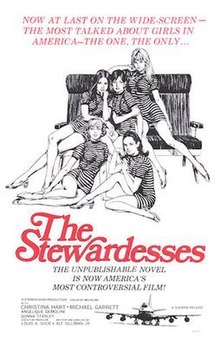
Widescreen images are displayed within a set of aspect ratios used in film, television and computer screens. In film, a widescreen film is any film image with a width-to-height aspect ratio greater than 4:3 (12:9).

35 mm film is a film gauge used in filmmaking, and the film standard. In motion pictures that record on film, 35 mm is the most commonly used gauge. The name of the gauge is not a direct measurement, and refers to the nominal width of the 35 mm format photographic film, which consists of strips 1.377 ± 0.001 inches (34.976 ± 0.025 mm) wide. The standard image exposure length on 35 mm for movies is four perforations per frame along both edges, which results in 16 frames per foot of film.

70 mm film is a wide high-resolution film gauge for motion picture photography, with a negative area nearly 3.5 times as large as the standard 35 mm motion picture film format. As used in cameras, the film is 65 mm (2.6 in) wide. For projection, the original 65 mm film is printed on 70 mm (2.8 in) film. The additional 5 mm contains the four magnetic stripes, holding six tracks of stereophonic sound. Although later 70 mm prints use digital sound encoding, the vast majority of existing and surviving 70 mm prints pre-date this technology.

IMAX is a proprietary system of high-resolution cameras, film formats, film projectors, and theaters known for having very large screens with a tall aspect ratio and steep stadium seating, with the 1.43:1 ratio format being available only in few selected locations.

CinemaScope is an anamorphic lens series used, from 1953 to 1967, and less often later, for shooting widescreen films that, crucially, could be screened in theatres using existing equipment, albeit with a lens adapter.
3D films are motion pictures made to give an illusion of three-dimensional solidity, usually with the help of special glasses worn by viewers. They have existed in some form since 1915, but had been largely relegated to a niche in the motion picture industry because of the costly hardware and processes required to produce and display a 3D film, and the lack of a standardized format for all segments of the entertainment business. Nonetheless, 3D films were prominently featured in the 1950s in American cinema, and later experienced a worldwide resurgence in the 1980s and 1990s driven by IMAX high-end theaters and Disney-themed venues. 3D films became increasingly successful throughout the 2000s, peaking with the success of 3D presentations of Avatar in December 2009, after which 3D films again decreased in popularity. Certain directors have also taken more experimental approaches to 3D filmmaking, most notably celebrated auteur Jean-Luc Godard in his film Goodbye to Language.
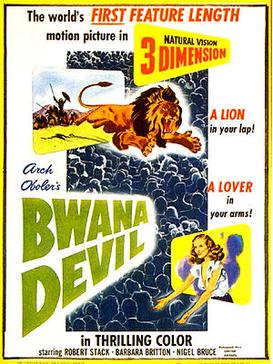
Bwana Devil is a 1952 American adventure B movie written, directed, and produced by Arch Oboler, and starring Robert Stack, Barbara Britton, and Nigel Bruce. Bwana Devil is based on the true story of the Tsavo maneaters and filmed with the Natural Vision 3D system. The film is notable for sparking the first 3D film craze in the motion picture industry, as well as for being the first feature-length 3D film in color and the first 3D sound feature in English.
A roadshow theatrical release or reserved seat engagement is the practice of opening a film in a limited number of theaters in major cities for a specific period of time before the wide release of the film. Roadshows would generally mimic a live theatre production, with an upscale atmosphere as well as somewhat higher prices than during a wide release. They were commonly used to promote major films from the 1920s–60s and build excitement.

Panavision is an American motion picture equipment company founded in 1954 specializing in cameras and lenses, based in Woodland Hills, California. Formed by Robert Gottschalk as a small partnership to create anamorphic projection lenses during the widescreen boom in the 1950s, Panavision expanded its product lines to meet the demands of modern filmmakers. The company introduced its first products in 1954. Originally a provider of CinemaScope accessories, the company's line of anamorphic widescreen lenses soon became the industry leader. In 1972, Panavision helped revolutionize filmmaking with the lightweight Panaflex 35 mm movie camera. The company has introduced other cameras such as the Millennium XL (1999) and the digital video Genesis (2004).
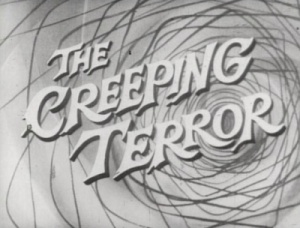
The Creeping Terror is a 1964 horror–science fiction film directed and produced by, and starring, Vic Savage. The plot is centered upon an extraterrestrial, slug-like creature that attacks and eats people whole in a small American town. Widely considered to be one of the worst films of all time, The Creeping Terror has become a cult film.
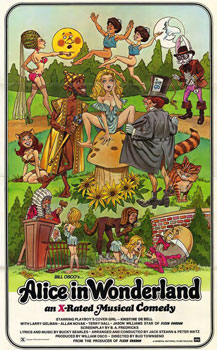
Alice in Wonderland is a 1976 American erotic musical comedy film loosely based on Lewis Carroll's 1865 book Alice's Adventures in Wonderland. The film expands the original story to include sex and broad adult humor, as well as original songs. The film was directed by Bud Townsend, produced by William Osco, and written by Bucky Searles, based on a concept by Jason Williams.

Frank Henenlotter is an American film director, screenwriter and film historian. He is known primarily for directing horror comedies, especially Basket Case (1982), Brain Damage (1988), and Frankenhooker (1990).
Super 35 is a motion picture film format that uses exactly the same film stock as standard 35 mm film, but puts a larger image frame on that stock by using the space normally reserved for the optical analog sound track.

Disney Digital 3-D is a brand name used by The Walt Disney Company to describe three-dimensional films made and released by Walt Disney Studios Motion Pictures mostly under the Walt Disney Pictures label and shown exclusively using digital projection.
Count Floyd is a fictional character featured in television and played by comic actor Joe Flaherty. He is a fictional horror host in the tradition of TV hosts on local television in both the United States and Canada.
Cine 160 is a 35 mm film projection process proposed by Allan Silliphant whereby a single frame of film would occupy a length of six film perforations. This could then be used for either of two currently proposed applications: 3-D film projection from two images each occupying 3 perforations, or making anamorphically squeezed prints of 1.85 ratio films, which would use a greater amount of image area. The system is named Cine 160 because the six-perf frame uses 1.60 times the area of a conventional print. This system has not yet received any mainstream application, however, and it is unknown how receptive theater owners will be to the prospect, which will require significant expenses to re-fit projectors to the format.
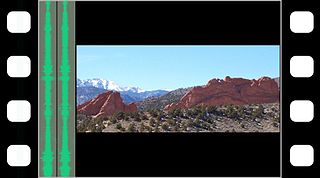
Anamorphic format is the cinematography technique of shooting a widescreen picture on standard 35 mm film or other visual recording media with a non-widescreen native aspect ratio. It also refers to the projection format in which a distorted image is "stretched" by an anamorphic projection lens to recreate the original aspect ratio on the viewing screen. The word anamorphic and its derivatives stem from the Greek anamorphoo, compound of morphé with the prefix aná. In the late 1990s and 2000s, anamorphic lost popularity in comparison to "flat" formats such as Super 35 with the advent of digital intermediates; however, in the years since digital cinema cameras and projectors have become commonplace, anamorphic has experienced a considerable resurgence of popularity, due in large part to the higher base ISO sensitivity of digital sensors, which facilitates shooting at smaller apertures.

U2 3D is a 2008 American-produced 3D concert film featuring rock band U2 performing during the Vertigo Tour in 2006. Directed by Catherine Owens and Mark Pellington, the film contains performances of 14 songs, including tracks from How to Dismantle an Atomic Bomb (2004), the album that the tour supported. The concert footage includes political and social statements made during the shows. It is the band's second feature film, following their 1988 rockumentary Rattle and Hum. Among several cinematic firsts, U2 3D was the first live-action digital 3D film.

Ruby is a 1977 American supernatural horror film directed by Curtis Harrington, and starring Piper Laurie, Stuart Whitman, and Roger Davis. Its plot follows a former gun moll in 1951 Florida who operates a drive-in theater, where bizarre supernatural occurrences begin to plague her staff of ex-mobsters, as well as her mute daughter.
